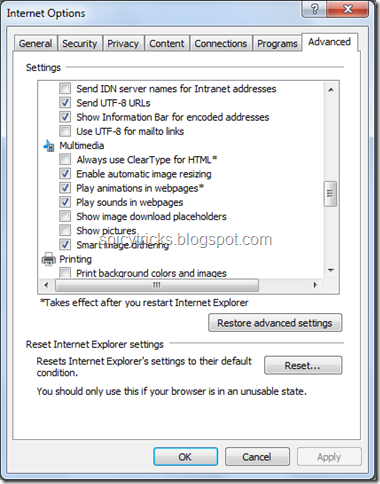Speeding Up the Internet
Customizing Internet Explorer is one way to have the Internet your way in Windows 7(also Vista), but it’s just part of the picture. The other way to optimize the Internet on your system is to speed up your browsing— by whatever means possible!
1Things That Slow Down Web Browsing
There are many things that can slow down your web browsing. Some of these issues have to do with your browser, others with your Internet connection itself.
- Understanding Connection Speed:
Let’s start with your Internet connection, which is one of two types: dial-up or broadband. Dial-up is the older and much slower technology, while broadband connections are significantly faster. It goes without saying, if you’re still connecting via dial-up, you will notice a significant improvement in speed by upgrading to a broadband connection of some sort. It used to be that everyone had dial-up connections, because that was the only type of connection available. A dial-up connection works by connecting your PC to a normal phone line, using a piece of hardware called a modem. The modem, which physically connects between your PC and your phone line, dials into your Internet service provider (ISP) and logs in to your personal account. Your ISP plugs the signal from your computer into the Internet, so that your computer is now connected to the Internet, through your ISP. When you’re done surfing the Web, you disconnect from the ISP by essentially hanging up the phone line.
The problems with dial-up connections are twofold. First, you have to connect and disconnect manually; you don’t have an always-on connection. Second, and most important, a dial-up connection is sloooow—transferring data at no more than 56.6 kilobits per second (Kbps). In the late 1990s, slow dial-up connections began to be supplanted by faster broadband connections. Unlike an analog dial-up connection, a broadband connection is an end-to-end digital connection. When you don’t have to modulate and demodulate the data from digital to analog (and back again), the all-digital data can travel much faster from your computer to other points on the Internet. Broadband connections are typically available from either your telephone company (via what is called a digital subscriber line, or DSL, connection) or your cable company. You can also receive broadband Internet via satellite (for those locations not served by DSL or cable) or the newer FIOS (fiber optic service) technology. Broadband speeds are considerably faster than dial-up connections, 1.5Mbps (that’s 1,500Kbps) or more for DSL and 6Mbps or more for cable Internet. At the lowest speeds, we’re talking 60 times dial-up speed for DSL and 120 times dial-up speed for cable broadband—more than enough of a difference to notice!
The speed of your actual connection, however, may differ from these general data transfer speeds. That’s because different Internet service providers offer different speed plans (higher speeds for a higher price, of course)—and because your actual speed may not be the same as the promised speed. Your distance from the nearest network node affects actual speed, as do the number of other users connecting at the same time, as do numerous other factors. So just because your ISP promises blazing-fast 6Mbps rates doesn’t mean that your connection will always be that fast.
That begs the obvious question, how fast is your Internet connection? There are several sites on the Web designed to test the speed of your connection; all you have to do is access the site and click the appropriate buttons. The site will download and upload some small files to and from your PC, measure how fast it all takes, and display your current upload and download speeds.
Some of my favorite speed test sites include the following:
• CNET Bandwidth Meter Speed Test (reviews.cnet.com/ internet-speedtest/)
• DSL Reports Speed Test (www.dslreports.com/speedtest)
• MySpeed (myspeed.visualware.com/)
Note that your connection speed may vary from day to day, or even at different hours of the same day. Test your connection a few times on different days of the week, calculate an average, and compare that to the speeds promised by your ISP.
- Understanding Browser Speed
Now let’s examine your web browser, which for most of us is Microsoft’s Internet Explorer. Internet Explorer 8 is the most recent version of the program, and the one included free with Windows 7. IE is a software program, not much different from a word processor or spreadsheet application, designed specifically to display HTML pages on the Web. Like any software program, it contains numerous configuration settings—some of which affect the speed at which web pages are displayed. As you’re probably aware, a typical web page contains a mix of text, graphics, and other elements. Text is easiest to display; not a whole lot involved with that. Graphics, however, can take longer to display, primarily because image files can be quite large. These large files take longer to download and thus longer to display in your web browser. Other page elements can include audio and video files, along with bits of JavaScript code. JavaScript is typically used to insert “applets” (small applications) into a web page; these applets often contain elements hosted on other websites. For example, a page might display a clock created with JavaScript; the code for the clock is on the web page itself, while the engine and graphics for the clock are hosted on another site. Because of this dual-hosting nature of some JavaScript code, these applets can often take longer to display than elements hosted natively. Naturally, the more elements on a web page, the longer it will take your browser to display them. It’s not just a matter of download size; all those elements must be rendered for display by the browser, and this rendering takes computing horsepower and time. It’s no surprise that bigger web pages can really slow down your browser. Here’s something else that can slow down Internet Explorer: having multiple tabs open at the same time. Yes, IE8 is designed with a tabbed interface, the better to load multiple web pages simultaneously. But all those web pages have to be downloaded, rendered, and stored in memory. It’s just more work for the browser—and an overworked browser can be sluggish. Fortunately, many of these issues can be overcome by some simple configuration changes—or, in the most extreme case, a tweak to the Windows Registry. Read on to learn how to speed up your browser—and make surfing the Web go a lot smoother!
2Managing Your Cache
You might not know this, but Internet Explorer stores a temporary copy of each web page you visit, called a cache. The intent is to speed up browsing by letting IE access the local cache when you revisit a recent page. The cache, of course, is nothing but a file on your hard drive. As such, it takes up valuable disk space. And, although the cache is designed to speed up browsing, too big of a cache can slow Internet Explorer to a crawl. You see, over time your browser keeps adding web pages to the cache file—and these pages aren’t deleted automatically. So the more web pages you visit, the bigger the cache on your hard disk. And too large a cache file puts a drain on your web browser, because your browser has to sort through the cache every time you load a web page, looking for a cached version of that page. Simply put, a bigger cache takes longer to reference.
- Clearing Your Cache
The solution to cache-based sluggishness is to clean out the cache. In essence, what you do is delete the cache file; this “empties” the cache, frees up valuable hard disk space, and makes it much easier for your browser to search for previously cached pages. Fortunately, this is easy to do—even if it must be done manually.
Here’s how you clean out the cache in Internet Explorer 8:
1. Click the Safety button and select Delete Browsing History.
2. When the Delete Browsing History dialog box appears, as shown in Figure 1, check the Temporary Internet Files option.
3. Click the Delete button. This deletes the temporary cache file on your computer and should speed up browser performance.
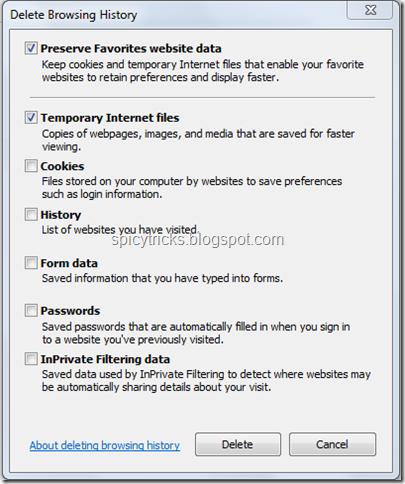 FIGURE 1 Deleting Internet Explorer’s temporary cache file.
FIGURE 1 Deleting Internet Explorer’s temporary cache file.
- Clearing Your Cache Automatically
If you don’t want to delete the cache on a regular basis, Internet Explorer can automate the process for you. All you have to do is enable the option that automatically clears the cache when you close the browser.
Follow these steps:
1. Click the Tools button and select Internet Options.
2. When the Internet Options dialog box appears, select the Advanced tab.
3. In the Settings list, scroll down to the Security section and check the option Empty Temporary Internet Files Folder When Browser is Closed.
4. Click OK.
- Changing the Size of Your Cache
You can also change the size of the Internet Explorer cache. The smaller the cache, the speedier Internet Explorer will be.
Here’s how to change the cache size in Internet Explorer 8:
1. Click the Tools button and select Internet Options.
2. When the Internet Options dialog box appears, select the General tab.
3. Click the Settings button in the Browsing History section.
4. When the Temporary Internet Files and History Settings dialog box appears, as shown in Figure 2, set the Disk Space setting to the desired number.
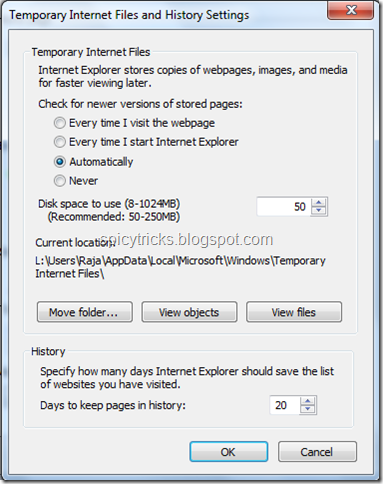 FIGURE 2 Configuring the size of the browser cache.
FIGURE 2 Configuring the size of the browser cache.
What is the best size for your cache file? While you can set a cache as small as 8MB, I recommend something in the 50MB range. Anything much smaller is less than useful, and anything much larger just takes up disk space and slows down your browser.
3Dealing with Cookies
Just as your browser stores a temporary copy of each web page you visit, it also stores information about those pages, in the form of cookies. A cookie is a small file, created by a website but stored on your PC, which contains information about you and your activities on that website. For example, a cookie file for a particular site might contain your user name, password, and the most recent pages you visited on that site. The cookie file created by a site is accessed by that site each time you visit in the future, and the information used appropriately. Aside from the privacy concerns of all these websites tracking your activities, cookies can also slow down your web browser. That’s because, over time, you accumulate a lot of cookies. These files, although small, can take up significant amounts of hard disk space; in addition, your browser must sort through them all to find the cookies it needs when accessing a specific site. The more cookie files on your hard drive, the harder your browser has to work.
- Deleting Cookies
As with your browser’s cache file, the solution to cookie-induced sluggishness is to delete all your cookies.
It’s quite easy to do in Internet Explorer:
1. Click the Safety button and select Delete Browsing History.
2. When the Delete Browsing History dialog box appears, check the Cookies option.
3. Click the Delete button.
Warning: Deleting all cookies may cause some websites to not remember you on your next visit.
- Avoiding Cookies
You can also configure Internet Explorer not to store some or all types of cookies, by adjusting the browser’s privacy level. just know that if you choose not to accept cookies, you can effect a slight improvement in browsing speed.
4Reconfiguring Other Settings
As discussed previously, Internet Explorer is a web browser that has lots of built-in features, some of which can slow down the display of web pages. Given that you may or may not need all of these features, turning a few of them off can speed up your web browsing. We’ll look at those features that most affect your browsing experience next.
- Don’t Display Graphics
Here’s a big one that may or may not appeal to you. Many web pages are overloaded with photos and other images; these images are big files that can take a long time to download and display, especially if you have a slow web connection. You can speed up the loading of graphics-intensive pages by simply turning off the graphics. That leaves you with a text-only web page, of course—but that page will load a lot faster than it did with all the images intact.
To turn off the display of images in Internet Explorer, follow these steps:
1. Click the Tools button and select Internet Options.
2. When the Internet Options dialog box appears, select the Advanced tab (shown in Figure 3).
3. Scroll down to the Multimedia section and uncheck the Show Pictures option.
4. Click OK.
And that’s not the only feature you can disable to speed up your browsing. While you’re in the Internet Options dialog box, you can uncheck the Play Animations in Webpages and Play Sounds in Webpages options— which will disable animations and sounds, respectively.
FIGURE 15.3 Speeding up IE by turning off graphics.
-
Disable ClearType
Internet Explorer 8 uses Windows’ ClearType technology to smoothly render type at all sizes. While I haven’t experienced this personally, some users have reported that ClearType has slowed down the performance of Internet Explorer on their systems.
To disable ClearType, follow these steps:
1. Click the Tools button and select Internet Options.
2. When the Internet Options dialog box appears, select the Advanced tab.
3. Scroll down to the Multimedia section and uncheck the Always Use ClearType for HTML option.
4. Click OK.
- Turn Off the SmartScreen Filter
Internet Explorer 8 includes a security feature called the SmartScreen Filter. This feature is designed to identify and warn you about so-called phishing websites—sites that pretend to be official sites but actually exist solely to steal your personal information. Unfortunately, the SmartScreen Filter can sometimes slow down web browsing, as it takes a bit of time to search the list of known phishing websites—which is why you can speed up your browsing by turning off the SmartScreen Filter. Here’s how to do it:
1. Click the Safety button and select SmartScreen Filter, Turn Off SmartScreen Filter.
2. When prompted by the next dialog box, check Turn Off SmartScreen Filter and click OK.
Warning: If you turn off the SmartScreen Filter, you need to be more vigilant about clicking links in emails and on web pages to avoid becoming the victim of phishing schemes.
- Disable RSS Feeds
How do you feel about a feature that few people use yet slows down everyone’s browsing? Yeah, me too—get rid of it. The feature I’m talking about is IE’s RSS feeds feature, which enables you to subscribe to RSS feeds from blogs and news sites and automatically display new postings and updates in the browser. If you don’t use the RSS feeds feature (and you probably don’t), you can disable it and speed up your normal web browsing.
Follow these steps:
1. Click the Tools button and select Internet Options.
2. When the Internet Options dialog box appears, select the Content tab.
3. Click the Settings button in the Feeds and Web Slices section.
4. When the Feed and Web Slice Settings dialog box appears, as shown in Figure 4, uncheck every option
5. Click OK.
Warning: Disabling RSS feeds also disables IE8’s web slices feature—which uses feed technology to display updates to website content.
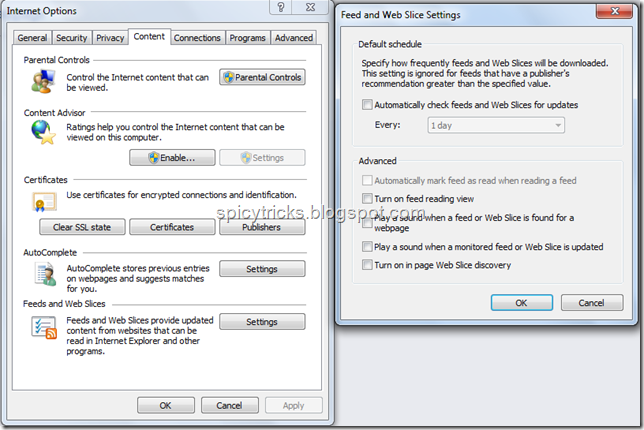 FIGURE 15.4 Disabling RSS feeds and web slices.
FIGURE 15.4 Disabling RSS feeds and web slices.
5Uninstalling Unnecessary Add-Ons
Some of what slows down Internet Explorer are add-ons to the main program. These auxiliary programs require more computing power than the browser does by itself, and sometimes access third-party websites that require additional downloads. You can speed up your browsing by disabling the least essential of these add-ons.
- Removing Third-Party Toolbar
Many websites like to install their own toolbars for Internet Explorer. While these toolbars make using those sites easier, they also put an extra load on Internet Explorer, which can make your browsing seem sluggish.
To remove unwanted toolbars from Internet Explorer, follow these steps:
1. Click the Tools button and select Toolbars.
2. Uncheck those toolbars you want to disable.
Warning: To completely remove some toolbars and their associated files from your hard drive, you may have to use Windows’Add/Remove Programs feature. (From the Control Panel, select Programs and Features.)
- Removing the SSVHelper Class Add-On
Here’s a somewhat esoteric plug-in that has been known to slow down IE’s browsing performance. The SSVHelper Class plug-in is a nonessential part of the Java plug-in (which itself is fairly necessary).
To disable this plugin, follow these steps:
1. Click the Tools button and select Manage Add-Ons
2. When the Manage Add-Ons window appears, as shown in Figure 5, select Toolbars and Extensions from the Add-On Types pane.
3. Select Java(tm) Plug-In SSV Helper from the contents list.
4. Click the Disable option.
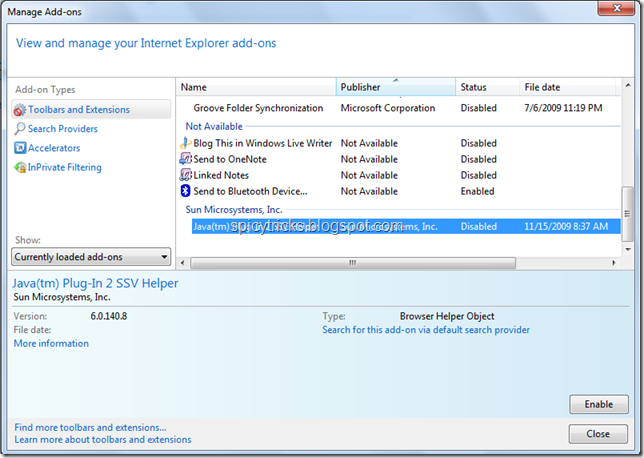 FIGURE 5 Managing add-ons in Internet Explorer 8.
FIGURE 5 Managing add-ons in Internet Explorer 8.
- Removing Other Add-Ons:
When you open the Manage Add-Ons window and select Toolbars and Extensions, you see a full listing of all the add-ons currently running in Internet Explorer. You may need all of these add-ons; you may not. For example, you might find that a particular website has installed an addon to view content on its site, but that add-on is not necessary when visiting other sites; that add-on is a prime candidate for removal. Determining which add-ons to keep and which to disable is mainly a matter of trial and error; there are no universal recommendations. I might be perfectly happy disabling the Shockwave Flash add-on (I hate unwanted Flash animations!), but other users might balk at not having any Flash animations display in their browsers. The key is whether you frequently visit sites that use a particular add-on; if not, you might as well disable it—and help speed up your browsing!

